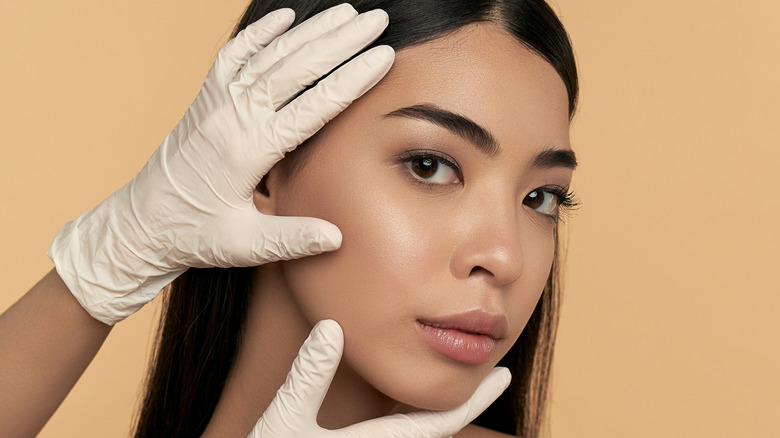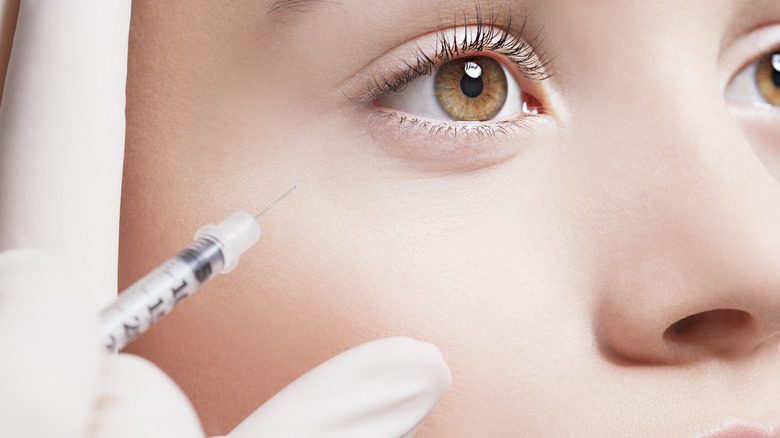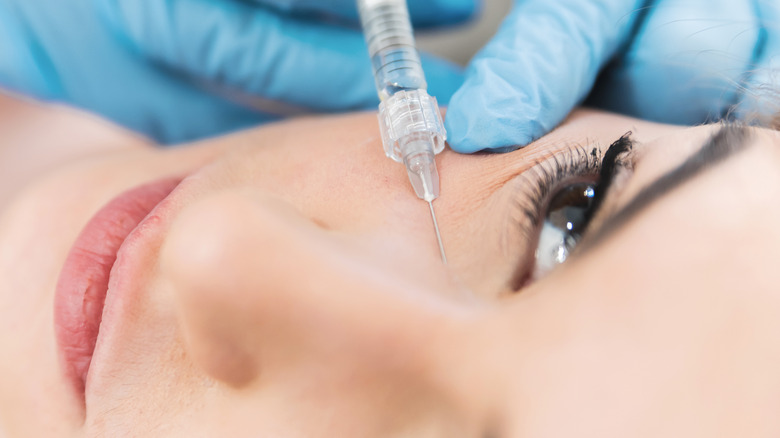All Your Biggest Questions About Under-Eye Fillers Answered
When the topic of facial fillers gets brought up, lip fillers are probably the first thing that comes to mind. But you'd be surprised to find out that there are many possible uses for filler for the face. Facial fillers are actually a really popular procedure used to address different aesthetic concerns, whether it's to even out facial structure, bring back some volume to the face, or add some height along the nose bridge.
Fillers give the promise of a quick fix with little to no downtime. You could literally get it done during your lunch break and pop right back into the office as if nothing happened. With this accessibility and ease, it's no wonder that facial fillers are becoming so common. In fact, it was one of the top non-surgical procedures in the U.S. in 2021, according to The Aesthetic Society. In that year alone, around 1.8 million patients got some kind of facial filler.
Be that as it may, procedures of any kind are worth your due diligence, regardless of whether they're non-invasive. Do the pros outweigh the cons? Here are all your biggest questions about under-eye fillers answered.
What is it for?
Under-eye fillers, also known as tear trough fillers, are a popular option for those who want to address the discoloration under the eyes due to the loss of fat in the lower eyelid area. This is not to be confused with the dark circles caused by discoloration.
The hollowing of the area can happen naturally with age, and it can also be influenced by lifestyle and genetics. Some are more predisposed to it than others. "Fillers are best for addressing volume loss and folds on the face," dermatologist Dr. Brian Hibler explained to Allure, adding, "They are also used to define certain features, like the nose, jawline, or chin, or to soften shadowing under the eyes."
There are different kinds of fillers available, but many doctors claim that the safest and most common ones are those made of hyaluronic acid. What makes it so appealing is that it claims to have little to no downtime, with the results visible as soon as the procedure is over. It supposedly gets better with time, too. "You will see long-term benefits from injectables because dermal fillers build collagen and elastin," dermatologist Dr. Dendy Engelman explained to Byrdie. With that said, some practitioners have differing thoughts on the matter and would suggest surgery as a better course of action.
Who are the best candidates for it?
Don't be so quick to book an appointment just yet, though — an important distinction must be made before you take the next steps. Under-eye fillers address volume loss in the lower eyelids and the darkness under the eyes that happens due to it, but cannot help those who are dealing with actual pigmentation or dark circles (via Self). Instead, the opposite effect can occur for those with dark circles who opt for fillers: The darkness will become more noticeable, and no one wants that.
If you need some help telling the difference between hollowness and dark circles, then a quick test with the use of a mirror and light can do just the trick. "Hold a mirror and look up so that bright overhead lighting hits you directly. If the shadow disappears, your dark circle is caused by a hollow. If the color is still there, it's pigment," dermatologist Rachel Maiman told Glamour.
Additionally, this procedure will not help those with puffy under-eyes. Since that is caused by fat, adding filler to the area will just make things worse. Whatever your case is, it would be best to get a second opinion from a licensed professional to ensure you're able to explore all possible options for your concerns. After all, fillers are not a one-size-fits-all approach.
What are the different kinds of under-eye fillers?
There are many different kinds of fillers to choose from: hyaluronic acid, poly-l-lactic acid, calcium hydroxylapatite, and fat transfer (via Healthline). But among the list, the most commonly used is hyaluronic acid.
"Hyaluronic acid is an ideal filler material because it is safe and effective and can be dissolved easily with an enzyme called hyaluronidase," nurse Kristina Kitsos explained to Glamour, adding, "Other types of fillers like poly-l-lactic acid (Sculptra) and calcium hydroxyl-apatite, or Radiesse, should never be injected in the undereye area." Hyaluronic acid fillers are less likely to cause any major side effects and are recommended due to their natural-looking results. The most common hyaluronic fillers, which you've probably already heard of, are from the brands Juvéderm and Restylane.
Fat transfer is another good option; however, it is more invasive than hyaluronic acid fillers. Getting a fat transfer filler requires the patient to undergo liposuction beforehand. Simply put, the extracted fat will be used as filler to be injected in the tear trough area. The upside of fat transfer fillers is that they usually last much longer than hyaluronic acid fillers.
How long does it take to heal?
Like with any procedure, healing time is determined on a case-by-case basis. But generally, there is barely any downtime after this procedure, and patients are able to continue with their regular schedule as soon as they're done with the appointment. However, it is likely to experience inflammation and bruising in the area for a week at most. "Swelling tends to peak 24 to 48 hours after injection and typically resolves within three days. Bruising can last longer but should resolve within one week," dermatologist Rachel Maiman shared with Cosmopolitan.
The instrument used during the procedure also affects the healing time. For tear trough fillers, in particular, many doctors prefer cannulas over needles. "Unlike needles, the blunt-tipped cannula does not usually injure blood vessels or nerves and thus minimizes bruising. It is also much less painful," dermatologist Rhoda Narins explained in the Journal of Drugs in Dermatology. The ingredients and instruments should be taken into consideration, as they will impact your side effects if any. Though cannulas are typically preferred, it's also ultimately a preference call on the end of the doctor, given that cannulas do have a learning curve and must only be performed by someone equipped to do so.
Doctors recommend a couple of sessions for this instead of doing it all in one go, as it's difficult to determine the actual results right away. "Give swelling and bruising at least two weeks to resolve before assessing your results," dermatologist Laurel Geraghty told Allure.
What is the aftercare like?
There is minimal aftercare involved for under-eye fillers, with efforts mostly focused on addressing possible swelling, redness, and bruising. To avoid swelling, dermatologist Desmond Shipp recommends avoiding contact with the area for at least three hours and keeping an upright position, even when sleeping, if possible (via Self). Additionally, patients should avoid excessive heat and exercise for the first 24 hours to help with both swelling and redness.
A cold compress is your best friend post-op. "Once you get your undereye filler, my recommendation is to ice the area immediately after treatment and to avoid anything that can increase blood flow to the area," Jaimie DeRosa, a plastic surgeon, explained to Glamour.
Once the face has normalized, which takes around two weeks, you'll probably have to visit your doctor again to assess the results. Your doctor might have to go in for a second time to even things out, which is totally normal. "The undereye is the most common place to need to tweak again," according to Dr. Dara Liotta.
How long does it last?
Patients often see a significant change in the area right after the procedure, but that isn't to be mistaken for the actual results just yet. With most of these procedures, especially for hyaluronic acid fillers, the actual results only really shine through months later.
Under-eye fillers last longer as compared to other facial fillers due to the area of placement. Since the tear trough area doesn't experience as much movement as compared to the lips or cheeks. As nurse Kristina Kitsos explained to Glamour, "the less movement, the longer it lasts."
The lifespan of the filler depends on a couple of factors such as how your body reacts and the type of filler used. Remember that the results of any facial fillers are temporary. It is widely believed that hyaluronic acid fillers last around 6 to 18 months, but Dr. Gavin Chan and Dr. Mobin Master's studies showed that it stays in the body much longer. From what they have studied, though the filler is still in the body, they don't show the "results" initially desired as they tend to disintegrate and migrate over time. Some patients would come to Dr. Chan complaining of swelling under the eyes, only to find that it was caused by fillers injected six to seven years ago. Dr. Chan has instead adopted an approach that requires smaller amounts of filler to the overall face to address the volume loss that happens with aging rather than focusing on a specific area.
What are the possible risks?
As with any procedure, there are a couple of possible risks when getting an under-eye filler. For the most part, any major risks are unlikely provided that you have the procedure done with a licensed professional.
Among the possible risks are filler migration, which is when the filler moves to a different area than where it was administered, and the Tyndall effect, which is blue discoloration under the eyes which is usually caused by injecting the filler incorrectly. The good news, though, is that both of these are reversible. But there are still some major irreversible risks associated with under-eye fillers. As dermatologist Shereene Idriss warned Allure, "with every kind of filler, there's the risk of unintentional injection into a blood vessel, which can result in skin death, scabbing, scarring, even blindness."
This is why finding a licensed and experienced professional is key."It's so important to do your research when you are looking for someone to work on your tear troughs," Dr. Kay Durairaj shared with Refinery29, adding, "all of us have been placing filler in under eyes because of our experience. And if we have years of clinical experience, we can place it with accuracy, precision, and safety."
What happens during the appointment?
Before getting started, the doctor should assess the state of your under-eye area and where the filler is to be inserted. If you've previously had fillers done, your doctor should even out anything "mid-face" — the under-eye and cheek area (via YouTube).
On to the main event. The doctor will apply a numbing agent along the tear trough area before inserting the filler. To insert the filler, your doctor will either use a needle or a cannula. The instrument of choice depends on the case and the doctor. However, cannulas are more popular for this procedure because they perform better on delicate areas such as the under-eyes, and are less prone to certain complications than needles are (via Face Med Store). After a couple of passes in both areas and some smoothing out, it's all over. Yup, it's pretty straightforward, and you're good to go on with your day.
In most cases, repeated visits are recommended versus having the filler done in one go. This is to allow the face to normalize and to check how the filler sets in. It's easier to add more filler to follow rather than overdo it the first time. When it comes to fillers, less is more.
How much are under-eye fillers?
The cost of under-eye fillers can vary greatly. According to Glamour, this can range "anywhere from $800 to $3000," with the cost of which being affected by the following: the location of where you're having the procedure done, the pricing of the doctor, and how much filler is needed for the specific case. How many syringes you need in a session depends on your doctor, but you typically won't need a full syringe for one eye.
Given the delicate nature of the under-eye area and how close a needle will be to your eyes, it's definitely not a procedure you should scrimp over. If you're looking to go to a licensed professional for less, you could try searching for an office outside of any major city, as the location can greatly affect pricing. With that said, don't let the price be your only deciding factor. "When it comes to your face, don't price-shop. Do your due diligence in researching your injector," Dr. Renée Moran advised Glamour.
Is there anyone who shouldn't get under-eye fillers?
Generally, fillers are off-limits for expecting and nursing mothers. There is a limited amount of literature on the topic, and some studies found that though it would not be harmful to the baby per se, it may be harmful to the mother. In any case, there isn't any harm in waiting until after childbirth.
It's worth reiterating at this point that fillers are for hollowing under the eyes which causes darkness in a certain light, but not for those with actual dark circles. So if you're looking to address pigmentation, this isn't the procedure for you.
As with any procedure, research is key. Check if you have any allergies to the ingredients used during the procedure, be it to the filler or the anesthetic, and discuss possible options with your doctor. Those with certain medical conditions aren't encouraged to get fillers as well. "Patients who are immunocompromised, or have a history of autoimmune disease, may also need to avoid fillers," according to dermatologist Michael Kassardjian (via Allure).










